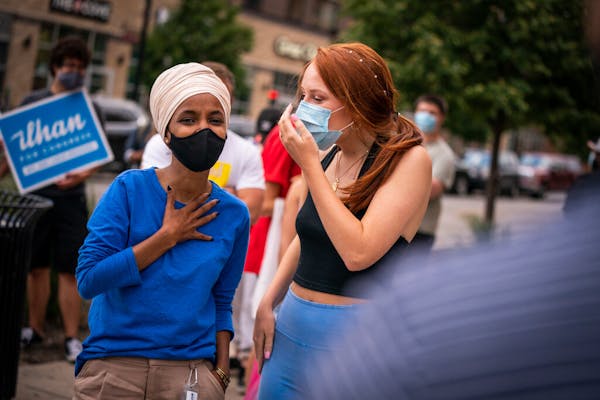The polls opened for 2020 primary voting on Tuesday as Minnesota mounts its first election amid COVID-19 face mask and social distancing requirements.
Thousands of voters already have taken advantage of loosened absentee ballot rules to mail in their choices in advance, many seeking to avoid lines and possible crowding around polling places throughout the state. Election officials say it is the largest expansion of mail-in voting in state history.
Even with what officials call a "tidal wave" of absentee ballots, in-person turnout could be particularly high in Minneapolis and Hennepin County, which have several competitive DFL legislative primaries and the nationally watched contest between U.S. Rep. Ilhan Omar and her top Democratic challenger, Antone Melton-Meaux. There's also a special election for Minneapolis City Council in the Sixth Ward, which runs from the Phillips neighborhood to Cedar-Riverside.
A flurry of legal challenges in advance of the elections has resulted in new rules waiving witness requirements for absentee ballots and allowing ballots to be received two days after the election, as long as they're postmarked by Election Day. The extra time could produce late results in some closely contested races, such as the DFL primary between Omar and Melton-Meaux in Minneapolis' Fifth Congressional District.
In-person voting also will look different, with allowances being made for social distancing, which could make lines appear longer than they are. Poll workers and election judges will wear masks, sanitize pens and have hand sanitizer on hand. All sites will have free disposable masks for voters.
Officials also will be managing potential conflicts about face masks, which are required indoors under Gov. Tim Walz's emergency orders. While some Republicans have resisted or actively opposed the face mask mandate, Secretary of State Steve Simon said nobody will be prevented from voting over refusal to wear a face covering. Voters who cannot or refuse to wear face coverings will be afforded curbside voting options outside.
Nevertheless, violators could potentially be subject to citations by local authorities, a predicament that has sparked confusion and at least one lawsuit.
Meanwhile, leaders in both parties are frantically urging those who have not already voted to get to the polls Tuesday.
Republican Party Chairwoman Jennifer Carnahan sent an e-mail plea Monday urging fellow Republicans to "exercise our right and freedom to vote."
DFL Party Chairman Ken Martin said DFLers are "pulling out all the stops to get Minnesota voters to the polls in support of our endorsed candidates."
Simon and other election officials are pleading for patience, saying it will likely take longer than usual to receive the results of some races. "On election night, we might not in every contest have the instant gratification we're used to," Simon said. "There might be certain contests, certain elections that we have to wait 48 hours, until Thursday night, to know the final results."
More voters have opted to vote by mail as the COVID-19 pandemic continues. By midday Monday, 637,463 absentee ballots had been requested, up from some 73,442 at the same time in 2018 and 34,660 in 2016. Of those, 423,032 have been returned and accepted.
In a typical year, voters might expect to know election results not long after polls close at 8 p.m., or early the next morning. But this year counting may not be completed on election night.
"Processing, storing, and tabulating a significantly greater number of mailed-in ballots, with only a couple of months to prepare for this emergency, presents an incredible challenge to these local governments and to our office," Simon said.
Election officials in multiple states also have said they do not expect to know the results on the same night of primary elections, with similar delays expected in the November general elections, when mail-in and in-person voter turnout could set records.
In New York, it took six weeks for election officials to declare the results of two congressional primaries.
"It might take a few days, or up to a week until ballots are all in and counted," Simon said. "This doesn't mean that anything has gone wrong."
Simon sees Tuesday's primary in Minnesota as a "dress rehearsal" for November, when even more voters could cast their ballots by mail, raising the specter of new legal challenges. The Trump administration and the Republican National Committee, which oppose expanded mail-in voting, already have contested new voting rules in several battleground states, including Minnesota.
By the end of primary day voting, election officials will know how many mail-in ballots were requested, how many voters cast their ballots in person, and how many mail-in ballots have been received so far — though not how many might come in by Thursday.
"Our commitment to accuracy and maintaining our long-standing system of safe, secure elections remains strong," Simon said. "This year, it's just going to take more time."

Minnesota State Patrol celebrates diverse new class of troopers

Fired Mpls. teacher accuses management of 'cancerous rot'

Jill Biden rallies women, teachers for the Biden-Harris ticket in Bloomington speeches
Neighbors, city officials at odds over Rochester lake dam

